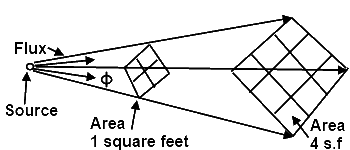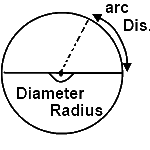Inverse Square Law
The inverse square law is common law of physics related to light discussion. The inverse square law states that
“When a light travels away from the light source then it covers an increasingly larger area such that the intensity of light on the any given area decreases as the square of the distance from the source.”
This relationship between the distance from a point source of light and the area covered by the beam is shown as:

This is for ordinary light case. The laser light also follow the same pattern that is its intensity decreases when it travels away from laser but its divergence is much less mean: it covers less area.
In figure ɸ is known as angle of divergence, because at this angle light spreads. Typically angles are measured in terms of degree or radians. A radian relates the radius of a circle to the distance of arc on the edge of the circle. When arc distance equals to the radius then angle generated “measured in radian rad”. This is shown as:

Flux
The term flux is a Latin word for flow. It is defined as: “the total number of lines of force passing through surface normally called the flux”.
Flux is a scalar quantity, denoted by ɸ and is expressed in Nm2/c.
Mathematically
ɸ = E.A (Electric flux)
or
ɸ = B.A (Magnetic flux)
